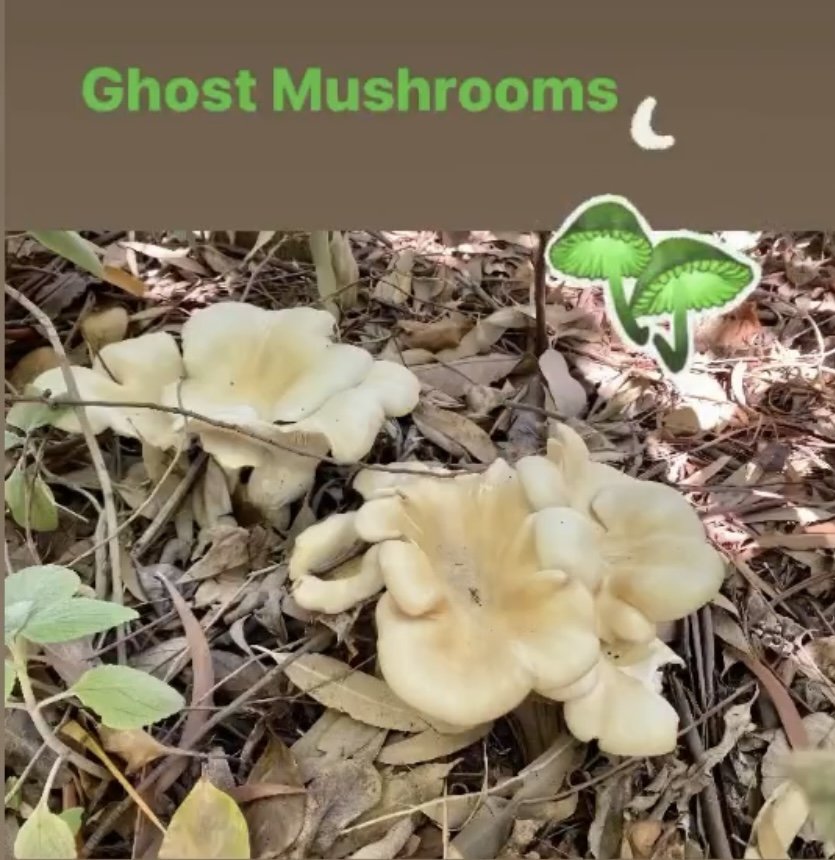by Carla Caruso
Ghost mushrooms, known for their eerie glow, have been spotted at the Adelaide Botanic Garden (Park 11).
Unfortunately, you won’t be able to see them shining in all their glory, though, as the garden isn’t open at night-time in autumn.
Instagrammer Skyward Exposures – a member of the FBGA Botanical Photography Group – alerted us to a patch near the Cascade sculptural fountain.
“Just in your right there is a tree trunk with orange mushrooms. They are behind that,” she said.
“There are supposed to be others in the garden [too], according to the staff, but I haven’t seen [them]. I tried to get permission to be in there after-dark to photograph them but wasn’t successful … Maybe next year!”
Ghost mushrooms spotted at the Adelaide Botanic Garden this autumn. Graphic: Skyward Exposures.
According to the State Department for Environment and Water, ghost mushrooms – like glow worms, fireflies, and sea sparkle – produce light known as bioluminescence through an internal chemical reaction.
During the daytime, the mushrooms are a creamy white colour, sometimes with brown, black or purple shading. But at nightfall, they turn it on, glowing green. The fungi can grow as big as 20cm across.
A State Herbarium spokesperson confirmed the sighting of the mushrooms at the Botanic Garden. “There are a few sites within the garden, where this fungus appears, where trees have been removed or damaged over time.
“This patch behind the Cascade fountain is the most recent and also the most abundant patch. It’s generally visible for about two to three weeks.”
A star-shaped mushroom captured by Fran Mussared last year in your Adelaide Botanic Garden (Park 11) .
The spokesperson added: “The ghost mushroom (Omphalotus nidiformis) gains nutrition from breaking down dead wood. So, it’s pretty common to find it fruiting on old stumps, logs and roots all over the place.”
However, the best, most reliable spot to see ghost mushrooms in the state is said to be Glencoe Forest, near Mount Gambier. Forestry SA opens Ghost Mushroom Lane to fungi enthusiasts during May and June each year, with access passes able to be purchased.
And, of course, ghost mushrooms are for looking at, not eating! As with many wild fungi, they’re poisonous, and unpleasant side-effects of consuming them can include vomiting and stomach cramps.
Graphic: SA Health.
SA Health posted this alert about mushroom season this month:
“Poisonous wild mushrooms appear after heavy rain. This year, we had a wet summer and the ground is still warm, making perfect growing conditions for mushrooms.
“Keep an eye out for children outside. Mushrooms are easily in reach and can look interesting and attractive to eat.
“Around two-thirds of the calls to the Poisons Information Centre are about mushroom poisoning involving children under five.
“Pets are also at risk from eating poisonous mushrooms. Call your vet immediately if your pet has eaten wild mushrooms.
“People who have lived overseas should be aware that highly toxic mushrooms in Australia can look very similar to edible mushrooms found in other countries.
“The fatal Death Cap found in South Australia can be easily mistaken for the Stubble Rosegill, which is very similar to the Paddy Straw Mushroom - a delicacy in Asian cuisine.
“Play it safe. Only eat mushrooms that have been purchased from a reliable greengrocer or supermarket.
“If you or someone you know has eaten a wild mushroom, do not wait for symptoms to occur. Contact the Poisons Information Centre on 13 11 26 and they will tell you if you need medical attention.
“Learn more about mushroom poisoning symptoms and prevention here.”
Graphic: SA Health.







